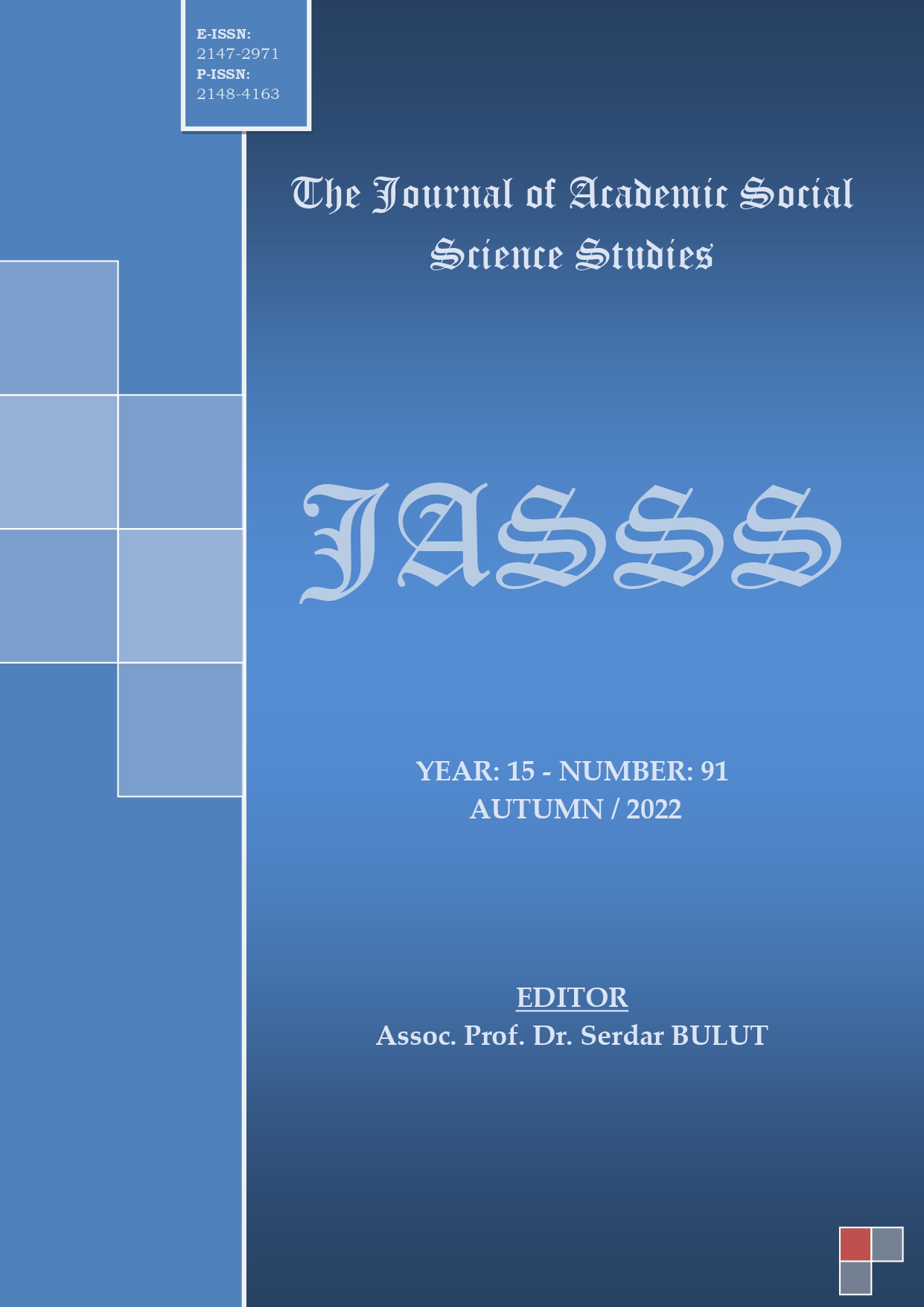Author :
Abstract
Dönemlerin özelliklerini tespit etmek, ancak o dönemden kalan eserlerin varlığıyla mümkün olmaktadır. Türk dili tarihi içerisinde de Orhun Kitabeleri, Kutadgu Bilig, Divanü Lugati't-Türk, Dede Korkut Hikâyeleri, Divan-ı Hikmet gibi kök eserler bulunmaktadır. Bu kök eserlerden bir tanesi de söylemiş olduğu şiirlerle Türkçenin gücünü gösteren Yunus Emre ve Divanı’dır. Sözün en doyurucu imkânlarını kullanarak, şiirini güzel söylemek kaygısı güden Yunus Emre, sözün kifayetsiz kaldığı durumlarda da şiirlerini başka araçlarla destekleme yoluna gitmiştir.
Etkili bir iletişimde sözlü ifadeyle birlikte sözsüz iletişim olarak adlandırılan beden dili de kullanılmalıdır. Beden dili hiç konuşulmadan kullanılan bir anlaşma şekli değildir. Sözlü iletişimi destekleyen bir tamamlayıcı ögedir. Yunus Emre’nin şiirlerinde yer alan kişiler/nesneler/kavramlar çoğu kez beden dilinin tamamlayıcı özelliğinden yararlanılarak ifade edilmektedir.
“El bağlamıştır çoğusu hep Allah’tandır umusu”, “Gördüm Pir’imin yüzünü ol kaygıyı sildi bugün”, “Âşık oldum ol ay yüze nisar oldum bal ağıza/ Nazar kıldım kara göze, siyah olup kaşa geldim”, “Kudret ününü işittim, kaynayarak coşa geldim”, “Ey aşk eri aç gözünü yer yüzüne eyle nazar”, “Onun körklü nazarı gönlümüz aynasıdır” vb. mısralarda örneklerini gördüğümüz sözlü anlatımın beden diliyle desteklenerek ortaya konulması şiirlerin genelinde çok sayıda karşımıza çıkmaktadır.
Yunus Divanı’nda beden dili açısından belirgin ifadeler olan “baş, yüz, el, kol hareketleri, göz ve bakış, giyim, kuşam, dış görünüş, davranış ve adap vb. unsurlar destekleyici öge olarak yer almaktadır.
Keywords
Abstract
Identifying the characteristics of the periods is only possible with the existence of artifacts from that period. In the history of Turkish language, there are root works such as Orkhon Inscriptions, Kutadgu Bilig, Divanü Lugati't Türk, Dede Korkut Stories, Divan-ı Hikmet. One of these root works is Yunus Emre and his Divan, which shows the power of Turkish with the poems he has said. Yunus Emre, who is concerned about saying his poetry well by using the most satisfying possibilities of the word, has chosen to support his poems with other means even when words are insufficient.
In an effective communication, body language, called nonverbal communication, should be used together with verbal expression. Body language is not a form of agreement that is used without speaking. It is a supplementary element that supports verbal communication. People/objects/concepts in Yunus Emre's poems are often expressed by making use of the complementary feature of body language.
“Hands are tied, most of them are always from Allah”, “I saw the face of my Pir, he erased the anxiety today”, “I fell in love with the moonface, I fell in love with the mouth/ I admired the black eye, I became black and came to the eyebrow.”, “I heard the fame of his power, I came to boiling over”, “O man of love, open your eyes to the earth and let it strength”, “His/Her flamboyant look is the mirror of our heart.” etc. the verbal expression, whose examples we see in the verses, is supported by body language and we encounter many in the poems.
In Yunus's Divan, there are clear expressions in terms of body language, "head, face, hand, arm movements, eye and look, clothing, outfit, appearance, behavior and manners, etc. elements are included as supporting elements.
Keywords
- Aksoy, Ö. A. (2007). Atasözleri ve Deyimler Sözlüğü: 2, Deyimler. Ankara: İnkılâp Kitabevi.
- Aksoy, Ö. A. (2007). Atasözleri ve Deyimler Sözlüğü: 2, Deyimler. Ankara: İnkılâp Kitabevi. Baltaş, Z. ve Baltaş, A. (1992). Bedenin Dili. İstanbul: Remzi Kitabevi.
- Başgöz, İ. (2021). Yunus Emre. İstanbul: Pan Yayıncılık.
- Bulut, S. ve Yavuz, S. (2020). Anadolu Türkçesinin Kurucusu Yunus Emre’nin Türk Diline Hizmetleri.(Ed.: N. İlhan vd.) Uluslararası Yunus Emre ve Anadolu Türk Yazı Dilinin Gelişimi SempozyumuBildiriler Kitabı, 04-06 Ekim 2018, Kırşehir, İçinde (s. 575-583). Kırşehir: Zekaevi Medya ve Yayıncılık.
- Çetin, N. (2015). İslâm Tarihinde Birlikte Yaşama Ahlâkına Tasavvuf Düşüncesinin Katkısı (HacıBektâş-ı Velî, Mevlânâ ve Yûnus Emre’den Örnekler). JASS Studies - International Journal of Social Science, 0(36), 281-298.
- Dinçer, A. (2017). Korku: Dili, Kavramlaşması, Kültürel Boyutu. Uluslararası Türkçe Edebiyat Kültür Eğitim Dergisi, 6(2), 769-798.
- Dinçer, A. (2019). Kara Sürmek Deyimi Üzerine. (Ed.: Ş. Çağın ve S. Dumantepe). Edebiyat Üzerine İncelemeler Rıza Filizok'a Armağan İçinde (s. 353-360). İzmir: Ege Üniversitesi Yayınları.
- Ercilasun, A. B. (2016). Başlangıçtan Yirminci Yüzyıla Türk Dili Tarihi. Ankara: Akçağ Yayınları.
- Korkmaz, Z. (1973). Yunus Emre ve Anadolu Türkçesinin Kuruluşundaki Yeri. Türkoloji Dergisi, 5(1), 13- 19.
- Köprülü, F. (1976). Türk Edebiyatında İlk Mutasavvıflar, (Yay. Haz.: O. F. Köprülü). Ankara: Diyanet İşleri Başk. Yayınları.
- Özdemir, E. (1976). Güzel ve Etkili Konuşma Sanatı. İstanbul: Varlık Yayınları.
- Özdemir, M. (2020). Yunus Emre’de Kozmolojinin Estetik Sunumu. Littera Turca Journal of Turkish Language and Literature, 6(3), 493-518.
- Özer, O. (2021). Tercüman-ı Bektaşiye. Ankara: Sonçağ Yayınları.
- Öztelli, C. (1997). Yunus Emre Yaşamı ve Bütün Şiirleri. İstanbul: Özgür Yayınları.
- Schober, O. (1994). Beden Dili (Davranış Anahtarı), (Çev.: Sueda Özbent). İstanbul: Arıon Yayınevi.
- Selçuk, B. (2008). Yunus Emre’de Bakma ve Görme Biçimleri. (Ed.: N. Sağlam, Ö. Oğuz ve N. Uzun).Aksaray Üniversitesi I. Uluslararası Yunus Emre Sempozyum Kitabı İçinde (s. 116-124). Aksaray: Aksaray Üniversitesi Yayınları.
- Sevgi, A. (2012). Yunus Emre’de İnsan Sevgisinin Evrensel Niteliği Üzerine. Turkish Studies, 7(1), 99-103. Tatçı, M. (1990). Yunus Emre Divânı Tenkitli Metin. Ankara: Kültür Bakanlığı Yayınları.
- Tatçı, M. (2013). Yunus Emre. TDV İslâm Ansiklopedisi, (C. 43). İstanbul: TDV Yayınları. Tatcı, M. (2014). Yûnus Emre Divân-ı İlâhiyât. Ankara: Semih Ofset.
- Uçar, İ. (2012). Kutadgu Bilig’de Beden Dili. Turkish Studies, 7(4), 3045-3058.
- Yılmaz, Ö. (2013). Zaman ve Mekânı Aşan Söylemleriyle Yunus Emre’de İnsan Anlayışı. Eskişehir Osmangazi Üniversitesi Sosyal Bilimler Dergisi, 14(Özel Sayı), 153-168.
- Yusuf Has Hacib (1979). Kutadgu Bilig I Metin. (Haz.: Reşid Rahmeti Arat). Ankara: TDK Yayınları. Yusuf Has Hacib (1985). Kutadgu Bilig. (Çev.: Reşid Rahmeti Arat). Ankara: TDK Yayınları.





